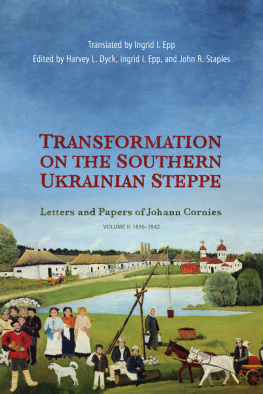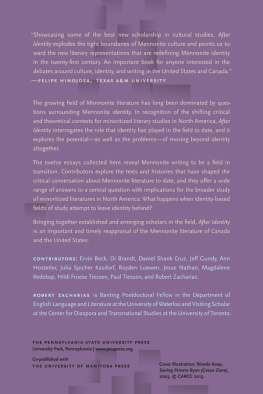TRANSFORMATION ON THE SOUTHERN UKRAINIAN STEPPE
Letters and Papers of Johann Cornies
VOLUME II: 18361842
Translated by Ingrid I. Epp
Edited by Harvey L. Dyck, Ingrid I. Epp, and John R. Staples
UNIVERSITY OF TORONTO PRESS
Toronto Buffalo London
University of Toronto Press 2020
Toronto Buffalo London
utorontopress.com
Printed in Canada
ISBN 978-1-4875-0449-6 (cloth)
ISBN 978-1-4875-3029-7 (EPUB)
ISBN 978-1-4875-3028-0 (PDF)
(Tsarist and Soviet Mennonite Studies)
Library and Archives Canada Cataloguing in Publication
Title: Transformation on the Southern Ukrainian steppe : letters and
papers of Johann Cornies / translated by Ingrid I. Epp ;
edited by Harvey L. Dyck, Ingrid I. Epp, and John R. Staples.
Names: Dyck, Harvey L. (Harvey Leonard), editor. | Staples, John Roy, 1961 editor. |
Epp, Ingrid I. (Ingrid Ilse), translator, editor. | Container of (work): Cornies, Johann,
17891848. Works. Selections. English.
Series: Tsarist and Soviet Mennonite studies.
Description: Series statement: Tsarist and Soviet Mennonite Studies | Includes
bibliographical references and indexes. | Contents: v. 2.
18361842 | Translations from the German.
Identifiers: Canadiana 20159035791 | ISBN 9781487504496 (v. 2 ; bound)
Subjects: LCSH: Cornies, Johann, 17891848. | LCSH: Cornies, Johann, 17891848
Correspondence. | LCSH: Germans Ukraine, Southern Correspondence. |
LCSH: Mennonites Ukraine, Southern Correspondence. | LCSH: Germans
Ukraine, Southern History 19th century. | LCSH: Mennonites Ukraine,
Southern History 19th century.
Classification: LCC DK508.425 G47 C67 2015 | DDC 940.2
This book has been published with the help of a grant from the Federation for the Humanities and Social Sciences, through the Awards to Scholarly Publications Program, using funds provided by the Social Sciences and Humanities Research Council of Canada.
University of Toronto Press acknowledges the financial assistance to its publishing program of the Canada Council for the Arts and the Ontario Arts Council, an agency of the Government of Ontario.

In fond memory of Ingrid Epp, 19382016.
A colleague and friend.
Preface
The eighteenth and nineteenth centuries saw the grasslands of the world open to agricultural settlement. In places as diverse as Argentina, the United States, Canada, South Africa, and Russia, people travelled to promised lands dreaming of peace, plenty, and escape from their overcrowded homes. They came with the urging and support of governments that viewed the grasslands as both a ground-spring of national wealth and a tabula rasa upon which to create new moral orders and shape new national identities.
Russias expansion east to Siberia and south onto the steppe was born of this vision, but in the south New Russia, as Catherine the Great named it the Russian imperial project intersected with geopolitical realities that gave it unique shape. Beyond New Russia lay the Ottoman Empire, a powerful competitor with its own imperial ambitions. Expansion towards the Black Sea and the Balkans meant certain conflict between the two great powers.
Geopolitics shaped the contours of Russias colonial project, and southward expansion was a carefully managed affair, constrained by the need to create communities that could support the Russian military. The clearest examples were the military colonies of peasant conscripts, relocated with their families to the New Russian frontier and ordered to build their own villages and grow their own food, all under harsh military discipline.
The Russian administrative ideal was cameralism, a theory of centralized planning and tight control, administered through an obedient and well-trained bureaucracy. It relied in part upon providing models of proper behaviour to the Russian and Ukrainian peasants who moved to the empires new territories. Russia actively recruited settlers from the German states as model colonists who could teach their progressive agricultural methods by example. Prussian Mennonites, renowned for their hard work and agricultural successes, became a central target for such recruitment.
The Mennonites who immigrated to the Russian Empire in the late eighteenth and early nineteenth centuries brought little with them beyond a deep-rooted Christian Anabaptist faith and a tradition of hard work. Settled in New Russia, they built villages, ploughed the rich prairie, and established model farmsteads. They built farm machinery, milled grain, and manufactured cloth, creating a bustling, prosperous community that, in the late nineteenth century, led the way in Russias nascent industrial revolution.
By 1914, Mennonites were also the target of Russian nationalist resentment, singled out for their German language, their unorthodox religious beliefs, and their prosperity. The First World War, and then the Revolution, brought confiscations and persecution. Those who could, fled; those who remained were impoverished and when they clung to their faith harried, imprisoned, and killed. By 1991 the Mennonites had become a blank page in Russian and Soviet history, unknown even to the people who occupied the homes they had once built. The surviving remnants in Siberia and Central Asia well knew to keep their beliefs to themselves.
The Russian Mennonite story remained alive in the migr communities that had left Russia in successive waves beginning in the 1870s and continuing into the 1940s. They settled in Canada, the United States, and South America, built new villages, and transplanted their Russian successes and religious disputes to their new homelands.
The story these Mennonites preserved was mainly one of faith and suffering. Filtered through their late Russian and Soviet experiences, it stressed their religious values and sense of community. It ignored (or did not understand) their role in the larger Russian story of colonization and economic development. This was true even in the work of secular historians, who depended almost exclusively on in-group Mennonite accounts.
This document collection addresses the first period of Mennonite settlement. It reveals that the foundations of Russian Mennonite prosperity were hard work, self-discipline, and entrepreneurial spirit. It likewise reveals the fermentation of religious beliefs in their community. Significantly, it also depicts a sometimes contentious, sometimes cooperative, constantly evolving relationship with neighbouring peoples and the Russian state.
This collection unveils the Russian colonial world through the eyes of Johann Cornies and his many correspondents. Cornies was the leading figure in his community an ambitious, entrepreneurial, and energetic reformer. He accrued great wealth and power, and he devoted himself to transforming New Russia. In Moscow, St. Petersburg, and the West, his keen mind and tremendous work ethic brought him acclaim. In the Mennonite community it brought him respect, but also deep hostility as his reform plans and his imperious manner generated controversy.













